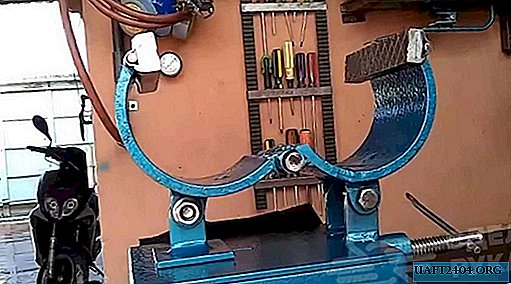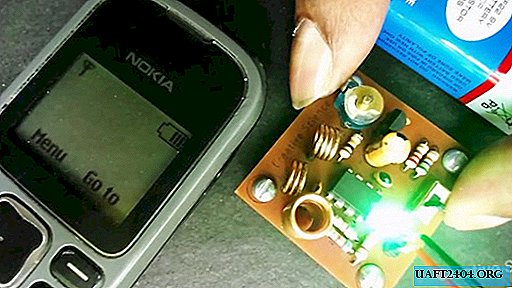Share
Pin
Tweet
Send
Share
Send

Now very often you can find outdated kinescope TVs in the garbage dump, with the development of technology, their packs are not relevant, so now they are mostly disposed of. Perhaps everyone saw on the back of such a television an inscription in the spirit of "High voltage. Do not open." And it hangs there is not easy, because in every TV with a kinescope there is a very interesting little thing called TDKS. The abbreviation stands for "transformer diode-cascade lowercase", in the TV it serves, first of all, to generate high voltage for supplying the picture tube. At the output of such a transformer, a constant voltage of as much as 15-20 kV can be obtained. The alternating voltage from the high-voltage coil in such a transformer is increased and rectified using the built-in diode-capacitor multiplier.
TDKS transformers look like this:

It is not difficult to guess the thick red wire extending from the top of the transformer, and is designed to remove high voltage from it. In order to start such a transformer, you need to wind your primary winding onto it and assemble a simple circuit called the ZVS driver.
Scheme
The scheme is presented below:

The same diagram in another graphical representation:

A few words about the scheme. Its key link is field-effect transistors IRF250, here the IRF260 is also well suited. Instead, you can put other similar field-effect transistors, but these are the ones that have proven themselves best in this circuit. Between the gate of each of the transistors and the minus of the circuit, zener diodes are installed for a voltage of 12-18 volts, I set the Zener diodes BZV85-C15, at 15 volts. Also, ultrafast diodes, for example, UF4007 or HER108, are connected to each of the gates. A 0.68 uF capacitor is connected between the drains of the transistors for a voltage of at least 250 volts. Its capacity is not so critical, you can safely put capacitors in the range of 0.5-1 μF. Quite significant currents flow through this capacitor, so it can be heated. It is advisable to put several capacitors in parallel, or take the capacitor to a higher voltage, 400-600 volts. The circuit contains a choke, the rating of which is also not very critical and can be in the range of 47 - 200 μH. You can wind 30-40 turns of wire on a ferrite ring, it will work anyway.
Manufacture




If the throttle is very hot, then you should reduce the number of turns, or take a wire with a thicker cross-section. The main advantage of the circuit is its high efficiency, because the transistors in it almost do not heat up, but, nevertheless, they should be installed on a small radiator, for reliability. When installing both transistors on a common radiator, it is necessary to use a heat-conducting insulating gasket, as the metal back of the transistor is connected to its drain. The supply voltage of the circuit is in the range of 12 - 36 volts, at a voltage of 12 volts at idle, the circuit consumes about 300 mA, with a burning arc, the current rises to 3-4 amperes. The higher the supply voltage, the greater the voltage will be at the output of the transformer.
If you look closely at the transformer, you can see the gap between its body and the ferrite core is about 2-5 mm. On the core itself, you need to wind 10-12 turns of wire, preferably copper. You can wind the wire in any direction. The larger the cross-section of the wire, the better, but a wire of too large a section may not go into the gap. You can also use enameled copper wire, it will crawl through even the narrowest gap. Then it is necessary to make a tap from the middle of this winding, exposing the wires in the right place, as shown in the photo:






It is possible to wind two windings of 5-6 turns in one direction and connect them, in this case also a tap from the middle is obtained.
When you turn on the circuit, an electric arc will occur between the high-voltage terminal of the transformer (thick red wire at the top) and its minus. Minus is one of the legs. Determining the desired minus leg can be quite simple if you bring “+” to each leg in turn. Air makes its way at a distance of 1 - 2.5 cm, so a plasma arc will immediately appear between the desired leg and plus.
You can use such a high voltage transformer to create another interesting device - Jacob's stairs. It is enough to place two straight electrodes with the letter "V", connect one plus to one, minus to the other. A discharge will appear below, will begin to creep up, at the top it will break and the cycle will repeat.
You can download the board here:
statya-vysokovoltnyy-transformator.zip 25.55 Kb (downloads: 608)
Test
In the photographs, Jacob's staircase looks very spectacular:


The voltage at the output of the transformer is deadly, therefore, safety precautions must be followed. After turning off the power, a high voltage continues to be present at the transformer output, so it should be discharged, closing the high-voltage terminals with each other. Successful assembly!





Watch test videos
High voltage experiments are always very colorful and fascinating.
Share
Pin
Tweet
Send
Share
Send











